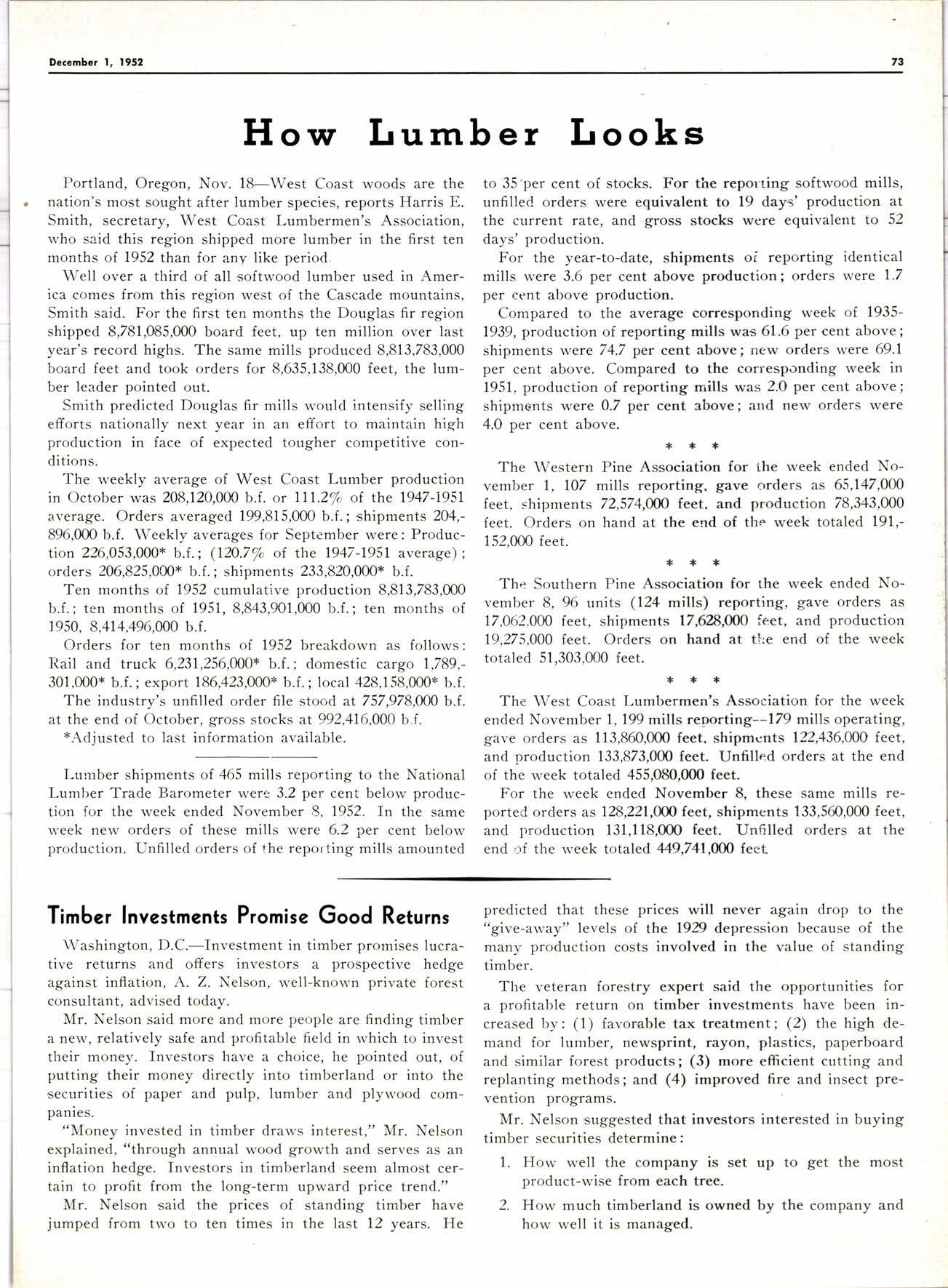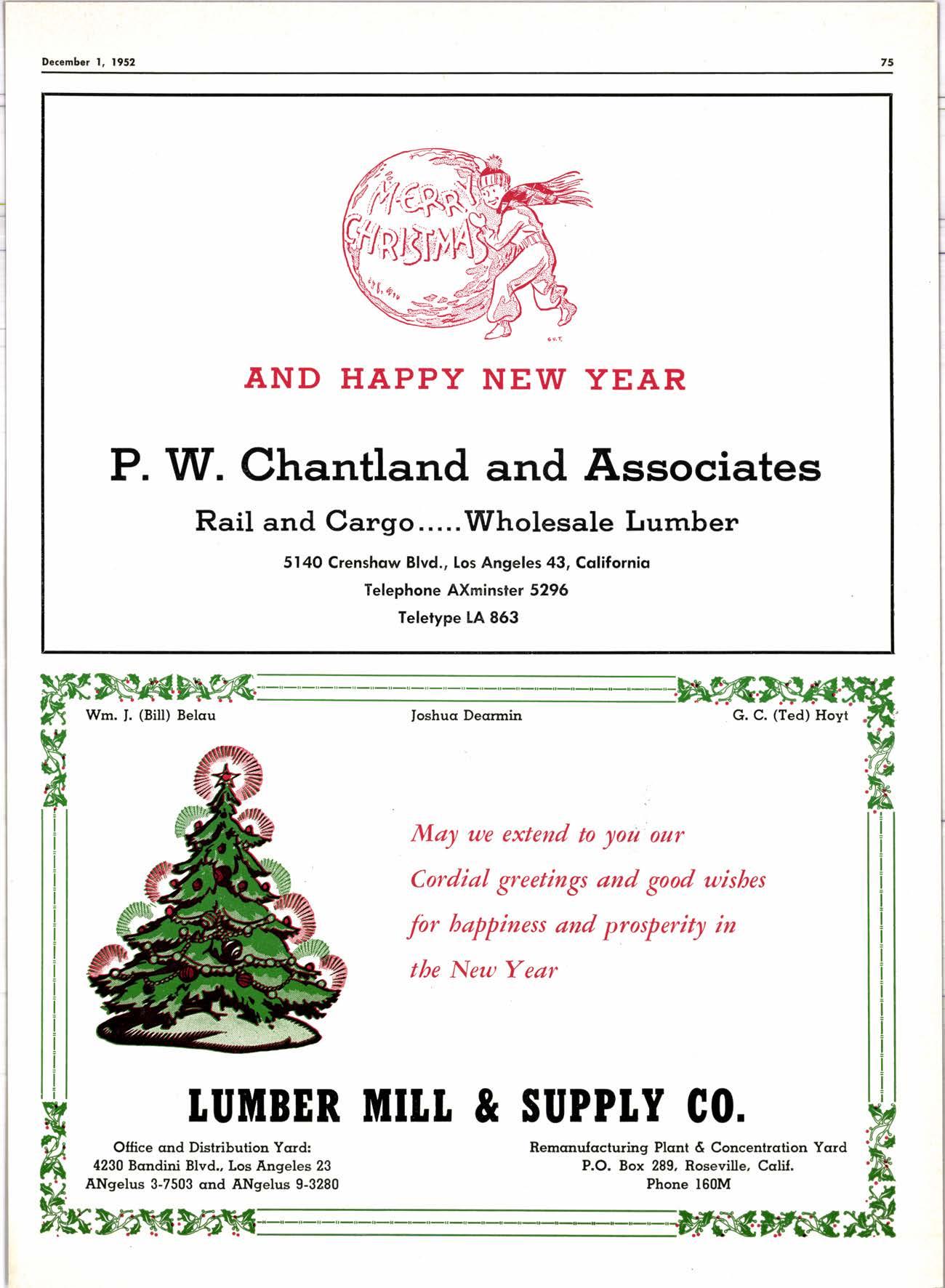
4 minute read
How Lrumber Irooks
Portland, Oregon, Nov. l8-West Coast woods are the r nation's most sought after lumber species, reports Harris E. Smith, secretary, West Coast Lumbermen's Association, who said this region shipped more lumber in the first ten months ol 1952 than for any like period.
Well over a third of all softwood lumber used in America comes from this region west of the Cascade mountains, Smith said. For the first ten months the Douglas fir region shipped 8,781,085,000 board feet, up ten million over last year's record highs. The same mills produced 8,813,783,000 board feet and took orders for 8.635.138.000 feet. the lumber leader pointed out.
Smith predicted Douglas fir mills would intensify selling efforts nationally next vear in an effort to maintain high production in face of expected tougher competitive conditions.
The weekly average of West Coast Lumber production in October was 208,120,000 b.f. or 111.2/o of the 1947-195I average. Orders averaged 199,815,000 b.f.; shipments 204,896,000 b.f. Weekly averages for September were: Production 226,053,000* b.f. ; Qn.7/o of the 1947-1951 average) ; orders 206,825,0m* b.f.; shipments 233,820,000* b.f.
Ten months of 1952 cumulative production 8,813,783,000 b.f. ; ten months of 1951, 8,843,901,000 b.f.; ten months of 1950, 8,414,496,000 b.f.
Orders for ten months of 1952 breakdown as follows: Rail and truck 6,231,256,000* b.f.; domestic cargo 1,789,301,000* b.f.; export 186,423,000* b.f.; local 428,158,000* b.f.
The industry's unfilled order file stood at 757,978,W b.f. at the end of October, gross stocks at 992,416,000 b.f.
*Adjusted to last information available.
I-urnber shipments of 465 mills reporting to the National Lumber Trade Barometer were 3.2 per cent below production for the week ended November 8, 1952. In the same vi'eek new orders of these mills were 6.2 per cent below production. Unfilled orders of the reporting mills amounted
Timber lnvestments Promise Good Returns
Washington, D.C.-Investment in timber promises lucrative returnsand offers inve'stors a prospective hedge against inflation, A. Z. Nelson, well-known private forest consultant, advised today.
Mr. Nelson said more and more people are finding timber a new, relatively safe and profitable field in which to invest their money. fnvestors have a choice, he pointed out, of putting their money directly into tirnberland or into the securities of paper and pulp, lumber and plywood companies.
J'Money invested in timber draws interest," Mr. Nelson explained, "through annual wood growth and serves as an inflation hedge. fnvestors in timberland seem almost certain to profit from the long-term upward price trend."
Mr. Nelson said the prices of standing timber have jumped from two to ten times in the last 12 years. He to 35'per cent of stocks. For the repouting softwood mills, unfilled orders were equivalent to 19 days' production at the current rate, and gross stocks were equivalent to 52 days' production.
For the year-to-date, shipments oi reporting identical mills were 3.6 per cent above production; orders were 1.7 per cent above production.
Compared to the average corresponding week of 19351939, production of reporting mills was 61.6 per cent above; shipments were 74.7 per cent above; rtew orders were 69.1 per cent above. Compared to the corresponding week in 1951, production of reporting mills was 2.O per cent above; shipments were 0.7 per cent above; and new orders were 4.0 per cent above.
The Western vember l, 107 feet. shipments feet. Orders on 152,000 feet.
Pine Association for the week ended Nomills reporting, gave c'rders as 65,147,000 72,574,W feet. and production 78,343,m0 hand at the end of the week totaled 191,-
The Southern Pine Association for the week ended November 8, 96 units (124 mills) reporting, gave orders as 17,062.000 feet, shipments 17,6?A,000 feet, and production 19.275.000 feet. Orders on hand at ttre end of the week totaled 51.303.000 feet.
*+*
The West Coast Lumbermen's Association for the week ended November 1, 199 mills reoorting--179 mills operating, gave orders as 113,860,000 feet. shipmcnts t22,436,00O feet, and production 133,873,000 feet. Unfilled orders at the end of the week totaled 455,080,000 feet.
For the week ended November 8, these same mills reported orders as 1?f,.,221,ffiO feet, shipments 133,560,000 feet, and production 131,118,000 feet. Unfilled orders at the end t-rf the week totaled 449,741,W IeeL predicted that these prices will never again drop to the "give-away" levels of the 1929 depression because of the many production costs involved in the value of standing timber.
The veteran forestry expert said the opportunities for a profitable return on timber investments have been increased by: (1) favorable tax treatment; (2) the high demand for lumber, newsprint, rayon, plastics, paperboard and similar forest products; (3) more efficient cutting and replanting methods; and (4) improved fire and insect prevention programs.
Mr. Nelson suggested that investors interested in buying timber securities determine: l. How well the company is set up to getthe most product-wise from each tree.
2. How much timberland is owned by the company and how well it is managed.


Hoo-Hoo Club No. 39 Meeting
With the California-Stanford football game scheduled for November 2,, the November 17th meeting of Hoo-Hoo Club No. 39 held at the Claremont Hotel, Berkeley, rvas designated as "Big Game Night." The speakers were Ed Welsh, former California backfield great and Assistant Athletic Director at IJ. C., and Don Burne'ss, former Stanford basketball star and all-around athlete.
A film of one of the recent big games was also shown. It was a great night for football enthusiasts, and the program was enjoyed by a large turnout. President Al Kelley presided at the after-dinner activities.
A carload of Douglas fir Christmas trees contains about 4,000 trees.
Lumbermen's Hi-Jinks
The Industrial Lumbermen's Club of Southern California will hold its annual Hi-Jinks Friday evening,- December 5, at the Industry Club, 5944 Avalon Blvd., Los Angeles. Mr. Bob Ringer will be the speaker of the evening.
The Club ofifrcers are Roy Stanton Jr., E. J. Stanton & Son, president; Charles M. Cooper, W. E. Cooper Lumber Co., vice president, and Don Braley, United States Plywood Corp., secretary-treasurer.
Floyd Hart, Timber Products Company of Medford, Ore., was a recent visitor to Los Angeles where he visited with Forest Products Sales Company and Ray Hill Lumber Company.
Hoo-Hoo Club No. 39 Will Hold Christmas Party December 17
The annual Chtistmas Party of Hoo-Hoo Club No. 39 will be held in the Leamington Bowl, Oakland, Wednesday evening. December 17.










